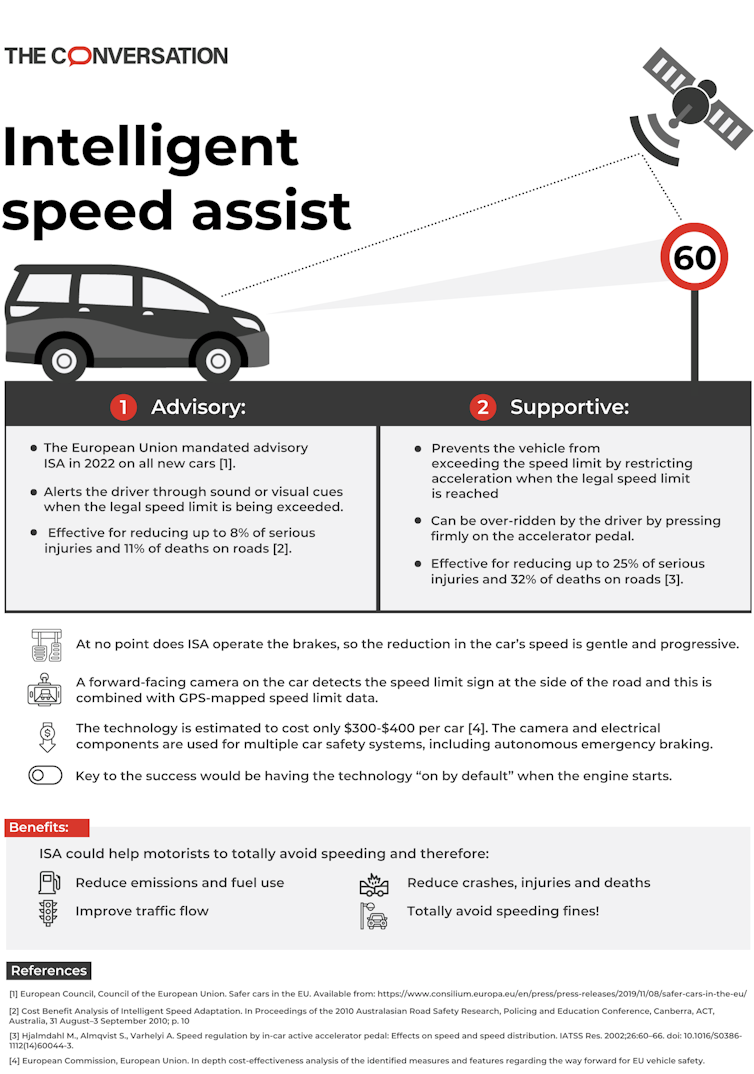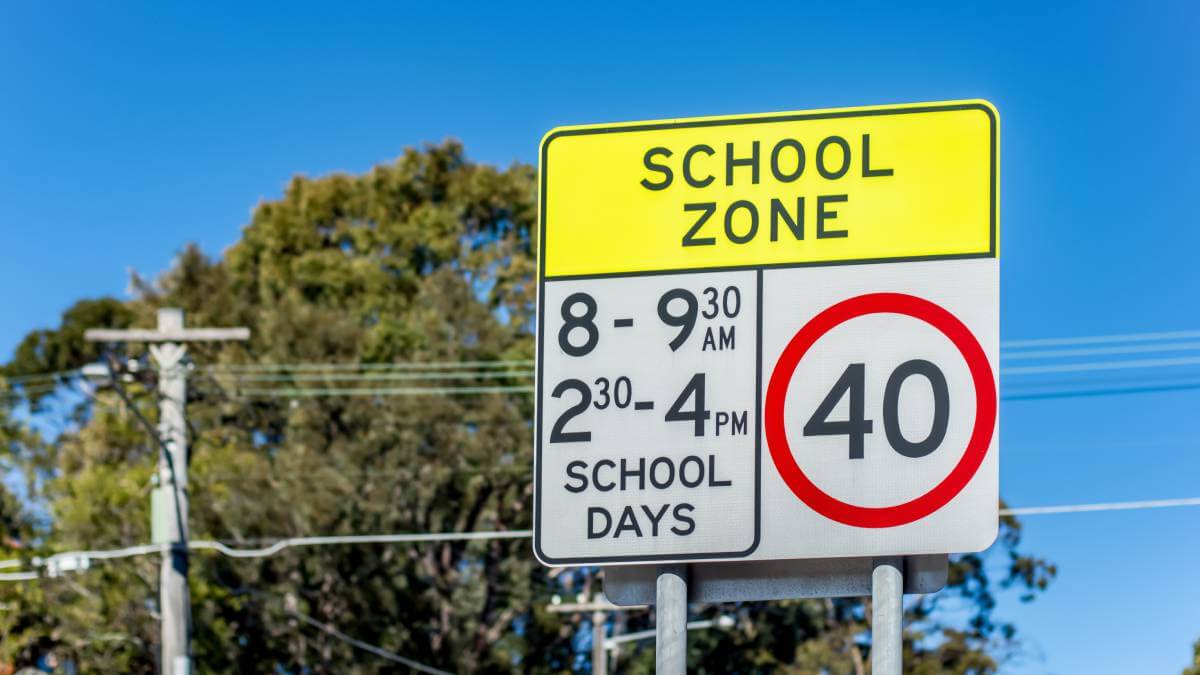Matthew Mclaughlin, The University of Western Australia; Courtney Babb, Curtin University, and Paul Roberts, The University of Western Australia
What if our cars didn’t allow us to speed? Or, at least, strongly encouraged us not to speed?
We could help motorists avoid speeding — and therefore reduce emissions and fuel use, improve traffic flow, reduce crashes, lower insurance costs, make streets feel safer to walk and cycle – and totally avoid speeding fines.
Reducing speeding is crucial if we are to reduce the rising road toll. More than 1200 people were killed on Australian roads in the past year.
It’s no wonder Australians want this technology – 81 per cent believe ‘intelligent speed assist’ technology is important for making roads safer.
Technology to stop speeding
‘Intelligent speed assist’ is the name of the low-cost technology that could save lives every year by reducing speeding.

The idea of helping drivers to avoid speeding is more than 100 years old. But early speed-limiting technologies proposed a top speed limit (similar to the way e-scooters are regulated in Australia), rather than allowing motorists the option to break the speed limit.
If we don’t do intelligent speed assist, what’s the alternative? Currently, we must constantly monitor speed limits and adjust our speed accordingly to avoid speeding. That means looking often at our speedometers.
There is some research to suggest continually taking our eyes off the road to review our speedometer could be dangerous.
Given how often speed limits can change on a route, and that we all make mistakes, it’s no wonder speeding is so common.
Will it work?
Installing intelligent speed assist in all cars could prevent at least 8 per cent and up to 19 per cent of all crashes Australia-wide. This represents up to 200 lives saved per year.
A NSW Centre for Road Safety trial found advisory intelligent speed systems reduced speeding in 89 per cent of vehicles, across more than 1.9 million kilometres of testing.
Intelligent speed assist is not yet a perfect system. Hurdles to overcome include:
- different speed sign coverage and designs from state to state
- maintaining an accurate map of speed limits across Australia for GPS
- potential over-reliance on the feature in varying driving conditions, such as wet weather, corners and so on.
But shouldn’t we be doing everything we can to overcome these hurdles, to make such a life-saving, child-saving technology work as well as it can?
What’s already been done?
Legislation in 2022 has made intelligent speed assist technology mandatory for all new cars sold in the European Union.
In Australia, if you drive a relatively new car, you may already have the option of intelligent speed assist. For example, if you drive a new Ford, you can activate its Intelligent Speed Limiter.
Intelligent speed assist adds to a growing list of in-vehicle safety technologies, such as auto emergency braking, lane keep assist and blind spot monitoring. We know older vehicles that lack such technologies are involved in more crashes.
What about older vehicles?
Cars have an average age of 10.4 years. So retrofitting older cars with intelligent speed assist technology has been trialled. Despite the European legislation, there’s no expectation of a wide-scale retro-fitting program.
It is common, though, to retrofit fleet cars such as government and company vehicles with intelligent speed assist. This improves fleet safety and distributes new technologies when these vehicles are sold on the second-hand market.
‘But I only speed a little bit’
Research shows most people think they’re better-than-average drivers. More than one in four Australians think it’s okay to speed if driving ‘safely’.
But you can’t speed and drive safely. For every 1km/h increase in speed, there is a 4 per cent increase in fatal crashes. If everyone was to increase their speed by just 1km/h, we could expect an extra 48 deaths a year.
Road deaths remain the number one killer of children in Australia and speed is the most common factor in a crash.
Current measures to reduce speeding haven’t gone far enough. Despite two in three Australian drivers admitting to speeding every week, only one in 10 got a speeding fine last year.
If you are worried about the government losing out on revenue, don’t. Road traffic crashes cost the Australian economy $27 billion a year. Speed camera fines generate just $1.5 billion a year.
Three actions to get started
Intelligent speed assist is not a silver bullet. But it is one of five crucial actions that can make zero road deaths possible. More than 200 cities around the world have already achieved this goal at least five times for a calendar year since 2009.
Here are three actions to get started:
- Install intelligent speed assist in all all public buses and government fleet cars – the NSW government fleet, for example, has 25,000 cars.
- Require intelligent speed assist for a five-star ANCAP safety rating.
- Adopt the EU legislation in Australia to require intelligent speed assist in all new cars.
We have an urgent problem, we have the technology, we have the evidence it works, so what’s stopping us using it to save lives on our roads?
The authors have provided footage online of intelligent speed assist in action, for free reuse.
Matthew Mclaughlin, Adjunct Research Fellow, The University of Western Australia; Courtney Babb, Lecturer in Urban & Regional Planning, Curtin University, and Paul Roberts, Associate Professor and Deputy Director, Western Australian Centre for Road Safety Research, The University of Western Australia
This article is republished from The Conversation under a Creative Commons license. Read the original article.
Have you had a speeding fine lately? Do you think the above technology is needed? Why not share your opinion in the comments section below?
Also read: Older drivers and common medications: a deadly combo?


What a great concept!!
Also how about Automatic Cruise Control Disable to disallow cruise control when:
1. outside temperature is below 4 degrees centigrade (danger of black ice)
2. Windscreen wipers are turned on (wet road or rain detected)
3. Towing (load detected on tow-bar, ie trailer or caravan)
In all these circumstances, use of Cruise Control can be dangerous.
Using GPS to acquire the speed limits for roads is not going to work. The only way is to use a camera with character recognition which many cars have now. The data based for road speeds in Australia is very poor, very hard to keep EVERY road up to date and ANY change in limits will not be reflected in the GPS data for days, weeks, months. It may work in Europe with their small countries and high population numbers but not here.
Just another attempt to intrude into personal freedom and responsibility. Coming from a leftist publication it follows that they are implying that no-one can be responsible for their own behaviour.
OBD11 became common on nearly all cars by the year 2000. Any vehicle since then can be easily and affordably fitted with a Heads Up Display (HUD) putting the speed right in front of the driver and hence the argument that checking the speedo can be distracting. is negated.
The “Every K over is a killer” is juvenile and not substantiated by facts. It is very safe to travel at speeds up to double the posted speed limit on clear roads. It is the situation where this becomes dangerous with many drivers not driving to the conditions and their competency.
Speed is indeed a significant factor in many fatal crashes, but it is rarely the only factor. Single vehicle crashes are quite often not accidental and capability impairing drugs are often present in the blood samples of the driver.
Across Australia there have been a number of serious crashes where one driver has been unlicensed (either because they were actually too young to hold a License or have had their License suspended for infringements) but it makes no difference to them getting behind a wheel and driving in a dangerous manner. In many of these crashes, the car has been driven illegally.
Rather than having “big brother” constantly in the car with the driver at all times, what would be more effective would simply be a visible presence of Police on the roads at all times.
Over the past 50 years, both the primary and secondary safety of the vehicles has improved significantly, many roads have been improved with better surfaces and alignments, but what has not changed has been the human element.
Driving skills have not improved but appear to have degenerated. Sometimes people need to feel the pain to make then realise that it isn’t always about them.
Mandatory road driving tests would be far better than some tech that does not make poor drivers more skilful. Half of road users should not be on the roads and driving should be recognized as a privilege, not a right. I see so many inconsiderate, inept, ignorant drivers who are oblivious to their own limitations, bad road manners, poor driving skills and generally an accident looking for a place to happen.
Get them off the road, teach children to understand road rules too and stop driving them to school in gas guzzling SUVs. If kids were fitter, faster and stronger both physically and mentally, there would be fewer of them killed.
Poor little Johnny and Janie. They eat so much rubbish food, and are so grossly obese and slow that their molly-coddled ways and fully-loaded food sensitivities are getting in the way of their future survival. Martial arts should replace the ‘fine arts’ to get them to harden up. Get bicycles for them instead of video games and send them out to dodge cars. I know we did that as kids and loved it.
Rubbish, show me the data to support such a claim.
“stop driving them to school in gas guzzling SUVs. If kids were fitter, faster and stronger both physically and mentally, there would be fewer of them killed.
Poor little Johnny and Janie. They eat so much rubbish food, and are so grossly obese and slow that their molly-coddled ways and fully-loaded food sensitivities are getting in the way of their future survival. Martial arts should replace the ‘fine arts’ to get them to harden up. Get bicycles for them instead of video games and send them out to dodge cars. I know we did that as kids and loved it.”